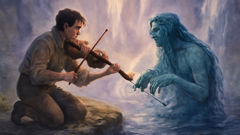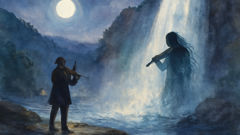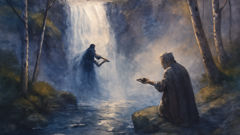Introduction
In the high country where fjords listen and birches bow to the wind, people still speak of a sound that belongs to neither river nor man alone. It begins as a tremor in the stones, a thin thread of melody woven from spray and depth, and then turns into a fiddle voice so precise that it seems to tune the world. That is the Fossegrim — a waterfall spirit who dwells beneath curtains of falling water, a being who shapes wood and string into something that makes boats still and hearts unclench. For centuries, shepherds and fishermen told of the Fossegrim teaching chosen learners the art of the fiddle, of pupils who climbed slick rock faces and left offerings of fish, wool, or a single silver coin to win a night's lesson. The rules were never simple: the offering had to be given with respect and correct ritual; the student had to play nothing but what the Fossegrim taught until the final note blurred. Those who obeyed found in themselves a mastery that felt borrowed from the current itself. Those who bargained or mocked discovered that music can reclaim its price. This retelling gathers those quiet, often contradictory threads — the rapture of sound, the danger of bargains with nature, and the small human hunger to learn what seems beyond reach. Across glens lit by aurora and under roofs darkened by peat smoke, the Fossegrim's music changed the way people remembered sorrow and joy. The melodies were not mere tunes but instructions in listening: how to hear the pulse beneath a pelt of ice, how to follow the hidden eddies of longing, how to let the bow find the moment where silence and sound meet. In these pages, you will meet seekers — a fisherman's daughter who needed music to keep her hands from wrath, a poor fiddler with ambition and empty pockets, and an old keeper of rites whose memory of the fiddle's touch held the line between blessing and loss. You will walk the wet stone steps, feel the spray like lace on your skin, and learn how a carved tune could carry a blessing, or a curse, depending on whether the listener kept their promise. Listen closely. The story itself is an offering.
The Rite of the Offering and the First Lessons
The instructions for finding a Fossegrim are simple in voice and complicated in practice. Hunters might pass them along in lantern-lit parlors, old women in the village added margins of caution, and a few traveling fiddlers embroidered them into lists of ways an eager heart could be broken. To find a Fossegrim you must first know the water that keeps secrets: a waterfall that has worn a hollow pool beneath it, with a rim of black stone and long, green moss. You must go in a season when the flow is steady—neither pinched by late frost nor swollen by spring thaw—and at an hour when human noise has retreated. Most of the time, dusk is best, when the light softens and the water's voice changes from a single roar to many layered tones that sound like breath. The seeker must bring a gift: not a trinket taken from the heart of another, nor a coin with a lie tucked behind it, but something from their labor—best a fish just caught, the finest wool, or a small carved thing that honors craft. The gift has to be prepared. The elderly in the tales speak of wrapping the gift in birch bark, tying it with a strip of leather, and placing it on a flat stone with both hands. The offering is never thrown. The rules are precise for a reason: water tests ceremony the way wind tests a shelter. One of the earliest learners in the stories is a young man called Eirik, a fiddler by accident rather than trade. Eirik's family were salt-harvesters and he had learned rhythm by hauling nets. Desiring mastery beyond his reach, he followed an old fisherwoman's directions over stones slick with algae and into the hush where the waterfall met the gorge. He brought a small, still trout, scaled and wrapped. He stood with it on a flat stone, and when the water changed its pitch he set the trout down and sang a short, true-name song his grandmother taught: a humility-song that said his purpose and asked permission. The Fossegrim's rules are less about punishment than about alignment. The spirit listens for how human wants fit into the larger current. A gift given in haste or greed is like feeding ashes to a fire. If a seeker opens themselves with clarity, the water answers. For Eirik there was a rustle of water—a sound that shifted from the waterfall's broad drum to a single, precise reed-like note. A shadow moved at the rim of the pool; a slender hand reached out, pale as river foam, plucking the leather string of an unseen fiddle. The Fossegrim revealed himself not as a giant nor entirely human, but as something that had learned craft from both nature and the world of men: a figure fashioned in wet wood and muscle, with hair like kelp and eyes reflecting deep pools. He did not speak in words as men do; he taught in demonstration and in the shaping of sound. His first lessons were odd by ordinary music-making standards. He tutored Eirik to listen to the waterfall's subdivisions—the small differences in pitch that water makes when it strikes stone in different spots. "Play where the ripple wants to rest," the Fossegrim indicated, in gestures that felt like raindrops patterning a surface. Eirik learned to lay his bow in the places where the spray whispered single notes. The bowing became less a pressure and more an invitation. The spirit corrected posture with a tilt that mimicked current and taught rhythm by tapping stone with his knuckles, producing resonances that Eirik matched with his heel placed on the wet rock. Practice sessions were not like ordinary lessons; they were soaked in cold and required patience. The student sat or knelt on damp stone, fingers staining from moss and bow hair wet with spray. For every trick learned—how to spin a tremolo that sounded like distant gulls, how to slip a melody into a pause as if it had been waiting on the other bank—the Fossegrim demanded a small return. Sometimes it was a promise to never reveal the exact marking of the waterfall. Other times the price was a true name spoken into the stream, a way of binding the student's fate to the music. Many tales insist on the purity of intent: Eirik, who came to honor craft rather than fame, was given an old tune that would make woodboats calm in storms. He used it once in a gale to stop a boat's panic and never sought applause again. Not every student had such restraint. In another story, a young fiddler named Solveig arrived with impatience in her bones and the hunger to be heard in large halls. She had sewn the finest cloth into a pouch for her gift and laid it carefully, but beneath her careful face burned a longing for recognition. The Fossegrim taught her a shard of music that cut through silence like sunlight through mist—a passage that could make any listener's breath stop. For a time, Solveig left the waterfall and played in town squares, and the people wept at the sweetness of the sound. But the bargain had been made: she was to play the Fossegrim's line only when the river claimed it, and she did not. In the end the music that should have been a blessing became an ache in her throat; she could play it only when her fingers were raw and the moon was west. The Fossegrim's corrections could be stern. When a pupil tried to copy the spirit without paying heed, their notes would crack like thin ice. When they tried to sell the tune, it fled their hands. The lessons teach a crucial principle of the folklore: music is not a possession but a participation. The Fossegrim's student must accept that mastery is shared and that skill given freely can be returned in ways the giver cannot command. Those who learned well learned also to listen to other lives—how the river moves around a reed, how birds ride warm currents—so that their playing could hold a village's grief as gently as it raised bread at a wedding. The rite of offering is thus a test of alignment: it measures humility, intent, and how one will fold the gift into communal life. Give in greed, and the water will remember greed; give in reverence, and the current will teach you the names of stones.

Consequences and the Long Reach of a Taught Tune
Music given by a Fossegrim does not vanish into applause. It follows the one who learned with the persistence of a current that remembers where each pebble once lay. For towns that welcomed a returned pupil, the gift could be a blessing: harvests calmed by a lullaby that soothed distressed animals, storms made less violent when a certain cadence was set against the wind, and funerals eased by a tune that smoothed the edges of mourning. But the stories are populated also with hard tales of payment, where lessons were treated as commodities and the Fossegrim's music became a mirror of human weakness. Take the case of the fiddler Kjell, a man of modest talent and greater vanity. After receiving a lesson that allowed him to play a bridge passage so beautifully that even the wealthy landlord stopped pacing to listen, Kjell sold his services to perform at a man's funeral who, rumor had it, had stolen the people's land. Kjell played with the polished skill received under the waterfall and was paid well. The Fossegrim heard about the transaction. In the middle of a moonless night, Kjell woke to a muting so absolute that he felt his hands as though they belonged to someone else. When he tried to play he found that the notes dissolved into the air, like breath in winter. He had broken an implicit rule: music taught by the spirit was to heal or to teach respect for nature and neighbor; it was never to be used simply to profit by sorrow. The consequences were not mere malediction. The Fossegrim's responses were instructional and proportionate—an attempt to reorient a misused gift. Kjell lost his music until he returned the wealth he'd gained and went again to the waterfall to relearn humility. The Fossegrim, in turn, led him through exercises that forced patience: hours spent drawing bow strokes as if painting the grooves in stone, listening with his bones rather than his ears. Many of the tales exist to place the learning within a moral ecology. They say that gifts taken from nature require gratitude and reciprocity, a careful bookkeeping between human need and natural order. When reciprocity is kept, music becomes a balm with extended effects. A fisherman's daughter named Asta learned a lullaby that allowed her to calm the nets when they snarled and to soothe storm-wrought fear among crews. She never played for coin but for community. Her music shaped the town's breathing: in lean years it slowed panic; in bountiful seasons it lightened steps. The folk there say that when Asta died old and certain, the river changed its tune for a week, a soft echo of gratitude that could be heard in the reeds. The Fossegrim's music also possesses an uncanny ability to alter memory. In certain tales a tune played by a true pupil could smooth a child's nightmares or make the haunted remember love rather than wrongs. The implication is a form of cultural therapy: music taught by the waterfall spirit can retune the way a community holds pain. But this power also carries hazard. A melody so perfect it erased the sting of sorrow entirely could make a people forget lessons they needed to avoid repeating mistakes. Consequently, the Fossegrim's lessons often included counsels that were not musical at all: admonitions about greed, about the dangers of cutting too close to the headwaters, and about honoring the dead without trading away truth. Perhaps the clearest and most haunting narrative concerns a woman named Hillevi who used the Fossegrim's skill to coax her ailing husband from sleep into a brief, joyous remembrance of their youth. He smiled, rose, and walked for a day as if he were young. She paid the cost she had promised: she would never again sing in full voice at the harvest. But because she had pulled memory from a life to reclaim a single bright day, her husband's long-term decline accelerated; she had shortened the arc of his quiet acceptance. The story asks: is a bright minute worth the slow fraying of a whole life? In that question the Fossegrim acts less as a dispenser of straightforward morality and more as a mirror for choices where beauty and consequence are tangled. There are also tales that reveal the Fossegrim as a guardian of boundary. Some students sought to steal the spirit's method by luring him out of his pool with loud music or a ring of silver. The Fossegrim, bound to his place, cannot be compelled but he can be offended. Stories tell of how a thief's fiddle would be filled with gravel, producing only dull thuds where once there was song, or of how a would-be master returned home only to find that every instrument in his workshop bent away from shape and cracked. These are not merely supernatural punishments but symbolic representations of the idea that technique divorced from place and care becomes hollow. In quieter tales, the Fossegrim himself sometimes showed grace. He could mend a bow broken in a child's earnest hands, teach a widow to find a new rhythm for her days, or slip into a lullaby that smoothed a returning soldier's shaking hands. His teachings were selective; he favored those who seemed to hold their music as a way of keeping community rather than raising themselves above it. Across the region, the memory of the Fossegrim held a function akin to law: it provided a cultural script for how to treat the gifts of the land. Counselers and elders reinforced his rules: never take a gift without giving thanks, never use nature's music purely for personal advantage, and always remember that the current has its own claims. The Fossegrim, then, is both muse and steward. He gives art and, by giving it, asks for continuance—reminding humans that every skill borrowed from the wild must be paid for, not always in gold but in humility, time, and attention. When the village fiddlers met in winter they often compared the alterations in their players' tone and posture, searching for the faint traces of the Fossegrim's teaching. In those conversations the old men and women traded small, precise instructions: shift the wrist like a river is turned by rock; let the fourth finger rest like moss; listen for the part of the bow that wants to wait. In so doing they kept alive both an art and a code of living in which music taught people to measure their wants against the river's capacity to give.

Conclusion
The Fossegrim's tale survives because it teaches a kind of necessary attention: how to listen and what to pay. In a modern telling, it reads like counsel against extracting nature for spectacle—music that comes from an intimate dialogue with water asks in return for care. Those who learned from the waterfall spirit often returned to live quietly, their playing threaded into the ordinary necessities of life—mending nets, calming children, blessing boats. The stories remind us that skill is never simply possession but a relationship: you take a tune, and you are reshaped by it, just as the river carves stone to gentler lines. The Fossegrim is not merely a being of legend but an idea about the costs of mastery and the humility of art. He stands at a boundary where human craft meets the unfathomable, testing whether the humans who come to him will give music back to the world or sell it for the fleeting warmth of coin or praise. If you travel to a waterfall and think you hear a bowed string threaded through the fall's roar, don't assume it is merely the echo of human hands. It may be the Fossegrim checking for those who remember to offer thanks. The offering is small and exacting, the lesson rigorous, and the rewards—when they are earned—last as long as the river keeps its path through the earth. Walk away with humility, and the music may follow you like a helpful shadow; take without regard, and you may learn how empty sound can feel. In that balance the old tales find their staying power: they teach how to hear, what to value, and how to let music be both a gift and a bond.













